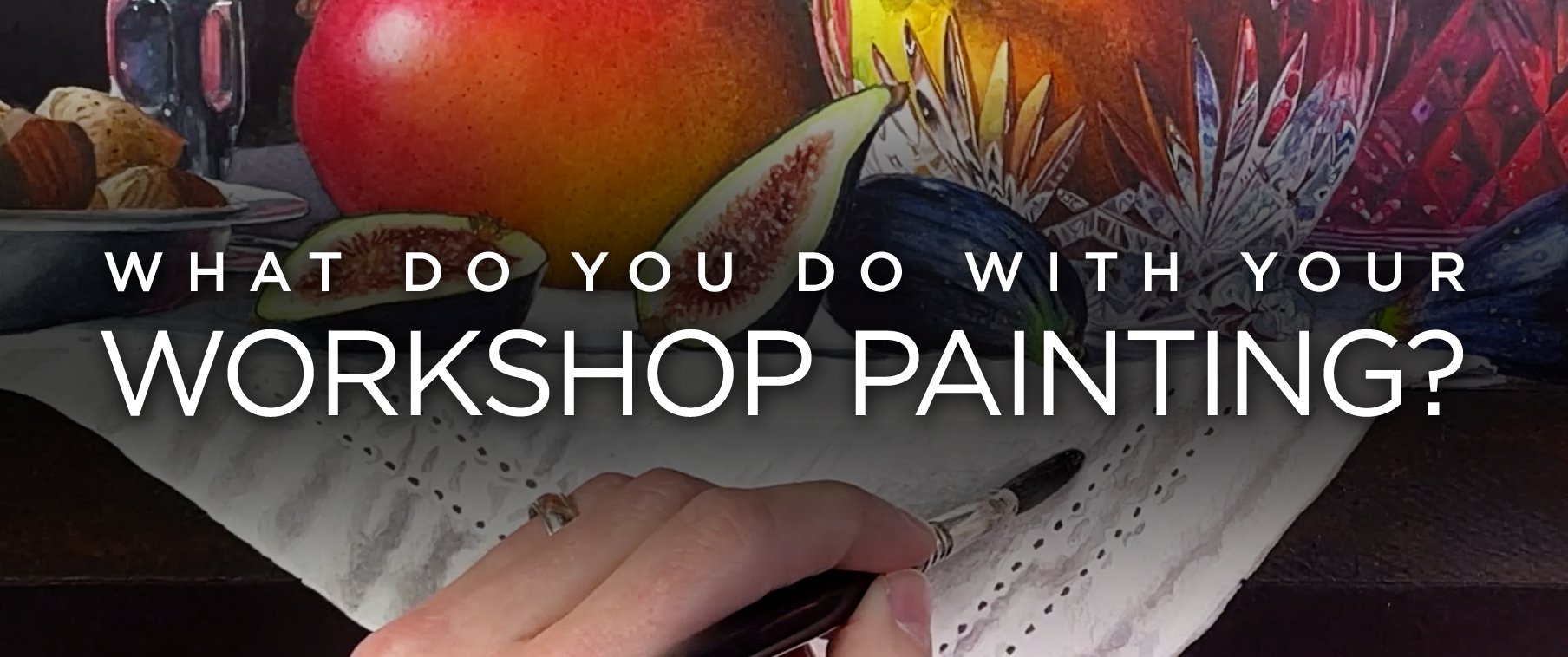In almost every workshop I teach, I inevitably get a series of questions concerning what students can and can’t do with their paintings from class.
Some questions are pretty straight forward with easy answers. “Can I enter this painting in an exhibition?” No. Almost every prospectus I’ve read clearly prohibits student work from competition. For example, here’s a fairly comprehensive rule from the National Watercolor Society on originality (emphasis added):
“Source material must be original and not derived from published images. ‘Original’ means the painting is the artist’s own idea, composition, and design, painted by hand (not computer generated), nor done in a class or workshop, nor repainted from another painting by the same artist from the exact same source image. Photo reference material must have been taken by you.”
Other questions can be more complicated to answer:
“Should I sign a painting done in a workshop? If so, is there a proper way to sign while being transparent about it being a copy?”
“If I copy a master artist, should I copy their signature as well?”
“Can I frame this painting and display it in my home?”
“Can I sell this painting if someone wants to buy it?”
“Can I put this painting in a gallery or my online store/website?”
“What about social media?”
Answers to these questions are not necessarily black and white, and copying art for educational purposes can be a controversial topic in the art world. While some argue that it is a valuable method to learn and improve artistic skills, others believe that copying devalues original artwork and undermines artistic integrity.
It’s important to understand that in a classroom setting, I am teaching and demonstrating painting techniques using my own original work. Students are copying everything from composition and design to brush choices and color palette.
I own the copyright of my work and copyright violations can come with serious legal consequences. I’m obviously not a lawyer, and I’m not giving legal advice, but I think it’s important for artists and students to carefully consider these issues.
Some of my artist friends are very strict when it comes to copying—they don’t allow it. They are very protective of their original work and I certainly understand this, especially in todays AI digital age.
My personal approach is a little more nuanced in that my style of teaching allows students to work with me through a painting, start to finish, essentially copying what I do and thereby learning from my process.
I’m probably more open to this approach because I learned a great deal from copying masters while I was in art school. In fact, art academies and ateliers have a long history of copying masters as an important part of the learning process.
A copyist working at the Met in the European Paintings galleries, ca. 1902–29
Perhaps you’ve been to museums and seen artists with easels set up, copying old master works that are on view. Many museums have copyist programs, and I think they are a great way to learn from the past. The Metropolitan Museum of Art and the National Gallery of Art are just a couple of the institutions with this type of program.
So I have no objection to students learning through this method of study. What happens next is where the thorny questions raised above come into play.
Can you sell a workshop painting? I wouldn’t, but I suppose there’s nothing I can do to stop you from a private sale. Certainly no reputable gallery would sell a copied artwork as an original. There’s a name for that sort of thing: forgery.
I also would not put a workshop painting on my website, or online store. It is not your original work, and misleading others into thinking it is wholly your creation is dishonest.
Regarding social media, I have no problem with people sharing what they have created in class as long as I’m tagged and it’s clear we were working together. It’s wonderful to share what you’ve accomplished and get feedback from your friends, while at the same time building your confidence in what you can achieve when you work hard. Sharing on social media also helps me by promoting my classes, which I certainly appreciate.
In my view, the important thing is attribution. Make sure it’s clear the painting is copied from someone else. When I was in art school I would sign copies like this:
Matthew Bird after William Bouguereau
Here’s an example from my Lemons & Silver Online Class, Carolina uses the French “après” for after:
Carolina Dealy signed her workshop painting with attribution.
I think this is a good way to sign a workshop painting. It allows students to show what they’ve accomplished while also acknowledging that it is not an original work and was done with aid of another artist.
To sum up, copying art with permission in a learning environment has a long and fruitful tradition. Copying art without proper permission or acknowledgement can infringe upon the rights of the original artist. It can undermine their creative ownership and potentially lead to legal consequences.
I’m sure there is much more to say on this topic and I’d love to hear your thoughts. Do you think workshop paintings should be sold? What are your views on copying masterworks? What are some things I’ve overlooked? Let me know in the comments below.




